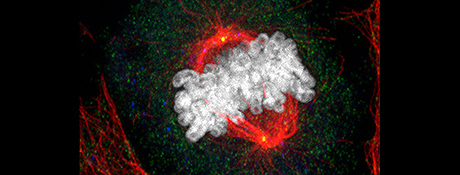How “Teamwork” between Egg and Sperm Works
12 August 2013

Photo: Gruß
Researchers from Heidelberg have decoded a previously unknown molecular mechanism in the fertilisation process of vertebrates. The team of scientists at the Center for Molecular Biology of Heidelberg University identified a specific protein in frog egg extracts that the male basal bodies need, but that is produced only by the reproductive cells of the female. This “teamwork” between the egg and sperm is what makes embryo development possible. The results of the research were published in “The Journal of Cell Biology”.
Several years ago Prof. Dr. Oliver Gruß and his colleagues used sensitive mass spectrometry to begin looking for protein materials that were newly synthesised during meiosis, as new egg cells were formed, thus making cell division efficient. In the process, they identified a previously little-known protein. The so-called synovial sarcoma X breakpoint protein (SSX2IP) is indeed formed during meiosis, but not required for it. “At first we were at a loss to explain the function of SSX2IP”, says Dr. Felix Bärenz, a member of Oliver Gruß’ working group.
The breakthrough came when the researchers went one step further, simulating fertilisation of the frog’s egg in the test tube. It was then they discovered that the SSX2IP produced after fertilisation and penetration of the egg by the sperm reanimated the basal bodies of the sperm. Because the egg loses its basal bodies as it matures, the reactivation of the male’s basal bodies is vital for the embryo’s development. They, in turn, build the embryo’s division apparatus – the mitotic spindles – without whose precise function continued cell division and successful embryo development would be impossible.
“In a cell culture, we were also able to prove that SSX2IP plays a similar role in human cells”, explains Prof. Gruß. Without the human SSX2IP protein, obvious errors occurred in the function of division apparatus. “It’s therefore quite conceivable that defects in SSX2IP synthesis during human egg maturation could lead to infertility or embryonic deformities”, surmises the Heidelberg biochemist.
Original publication:
F. Bärenz, D. Inoue, H. Yokoyama, J. Tegha-Dunghu, S. Freiss, S. Draeger, D. Mayilo, I. Cado, S. Merker, M. Klinger, B. Hoeckendorf, S. Pilz, K. Hupfeld, H. Steinbeisser, H. Lorenz, T. Ruppert, J. Wittbrodt, O. Gruß: The centriolar satellite protein SSX2IP promotes centrosome maturation. The Journal of Cell Biology 1 (202), 1 July 2013, p. 81-95, doi: 10.1083/jcb.201302122

